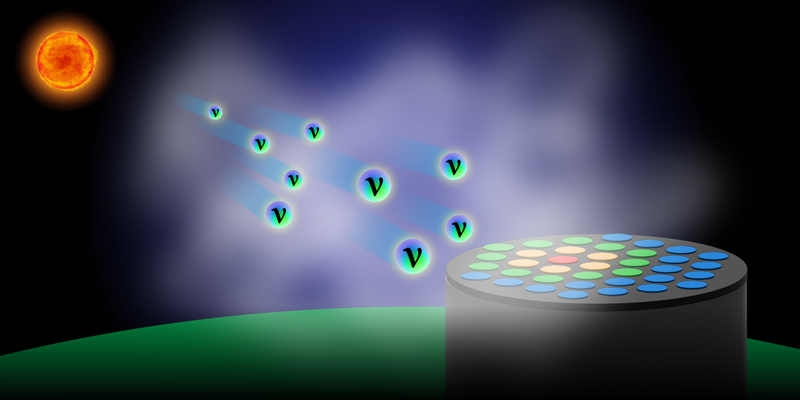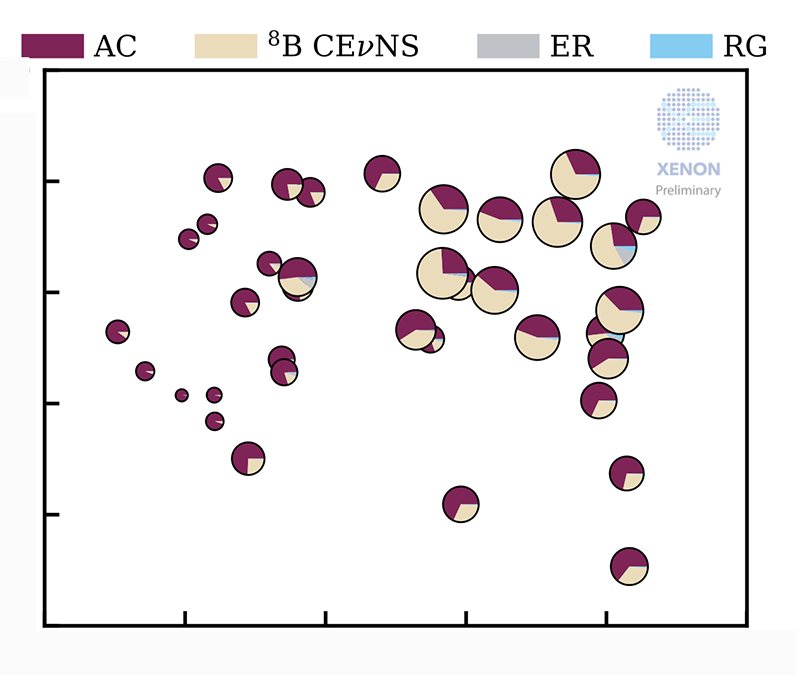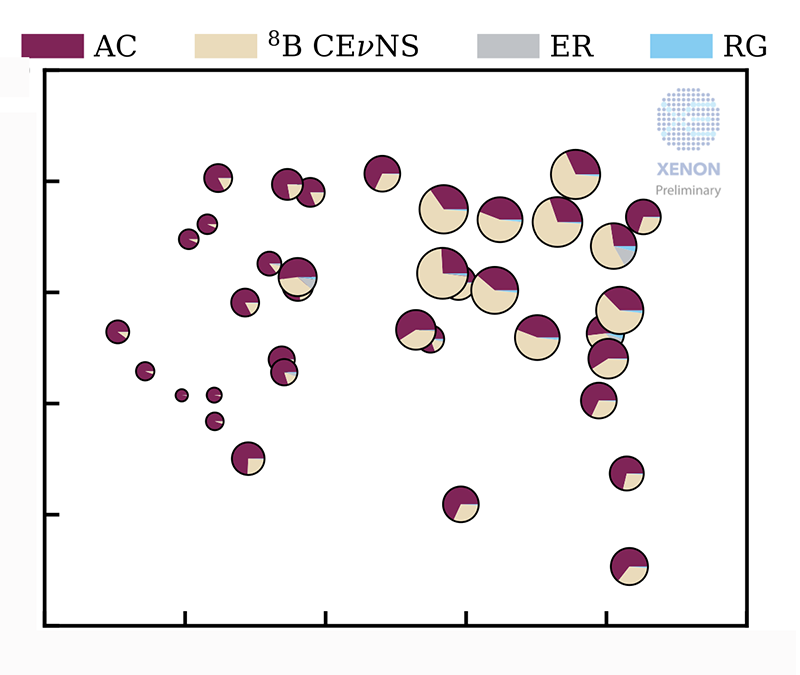First Glimpses of the Neutrino Fog
Several leading searches for dark matter operate in some of the deepest underground laboratories in the world, screened from cosmic rays and other backgrounds that could obfuscate a dark matter signal. But as these experiments keep pushing their sensitivities, they could be affected by a background that no layer of rock could block off—one produced by the ghostly neutrinos that pass through matter virtually unimpeded. This “neutrino fog” could potentially cloud the ability of these experiments to spot dark matter. (Fig. 1). Now two independent dark matter searches, run by the PandaX and XENON collaborations, report strong hints that their detectors have started to see the fog associated with streams of solar neutrinos [1, 2].
“This [result] is a great testament to the incredible sensitivity of these experiments,” says particle physicist Dan Hooper of the University of Wisconsin–Madison. Elisabetta Barberio of the University of Melbourne, Australia, calls the measurements a “remarkable feat,” noting that the neutrino fog won’t significantly impact dark matter searches for at least a decade. Neither Hooper nor Barberio were involved in the studies.
Searches such as those by PandaX and XENON target the leading particle candidate for dark matter—a weakly interacting massive particle (WIMP). Their approach involves giant tanks of purified and ultracold liquid xenon. If a WIMP happened to hit a xenon nucleus, it would cause a nuclear recoil, generating a detectable signal in the form of photons or electrons. A high-energy neutrino, however, can produce a signal that is remarkably similar to that of a WIMP. Researchers have long predicted that such signals can constitute a fog that could mask a potential signal from dark matter candidates in a certain parameter space.
The neutrino signals are generated by a process called coherent elastic neutrino nucleus scattering, or CE𝜈NS. The coherent nature of this process means that the neutrino interacts with the nucleus as a whole—with all of its neutrons and protons—making CE𝜈NSmore likely than other interactions with individual nucleons or electrons. Despite this large “cross section,” CE𝜈NSis hard to observe because a neutrino can only impart a tiny recoil on a nucleus. CE𝜈NSwas first detected in 2017 in an accelerator-based experiment harnessing the large flux of high-energy neutrinos available at the Spallation Neutron Source at Oak Ridge National Laboratory in Tennessee.
Now a much feebler CE𝜈NS signal from solar, rather than accelerator-produced, neutrinos has been reported both by the PandaX-4T experiment at the China Jinping Underground Laboratory and by the XENONnT experiment at the Gran Sasso National Laboratory in Italy. Both experiments employ a multiton volume of liquid xenon. Qing Lin of the University of Science and Technology of China and member of the PandaX Collaboration says that the result is an extremely important validation of the experiment. “Detecting such a rare signal proves our ability to detect a dark matter signal if it exists.” But the purported signal also opens up a new observational window for these projects. “This is the first measurement of astrophysical neutrinos with a dark matter experiment,” says Fei Gao of Tsinghua University, China, a member of the XENON Collaboration.
Each experiment analyzed data from two science runs taken over two years. The analyses suggested the detectors had spotted CE𝜈NSevents coming from neutrinos generated in the Sun by the radioactive beta decay of boron-8, an isotope produced by fusion reactions in the solar core. In both experiments, the energy distribution and number counts of the candidate CE𝜈NSevents were consistent with theoretical expectations based on current detector performance and on the well-characterized flux of boron-8 solar neutrinos.
XENONnT deployed an extensive machine-learning-based data analysis that allowed the team to isolate about 11 CE𝜈NSsignals from different types of backgrounds even without full knowledge of the physical origin of such backgrounds, according to Kexin Liu of Tsinghua University and Dacheng Xu of Columbia University, who worked on such analysis (Fig. 2).
PandaX-4T, on the other hand, reported up to 75 CE𝜈NSevents. The larger number comes from a trade-off, says PandaX-4T deputy spokesperson Ning Zhou: With a lower detection energy threshold, their experiment was sensitive to fainter signals but also suffered from larger backgrounds. Ultimately, PandaX-4T and XENONnT obtained similar statistical confidence for their identification of boron-8 CE𝜈NSevents—2.64 sigma and 2.73 sigma, respectively.
While these values are short of the stringent criteria often used in particle physics for “evidence” (3-sigma) or “discovery” (5-sigma) claims, researchers are confident about the interpretation. “We aren’t claiming the discovery of new physics but the measurement of a process that’s entirely expected,” says Gao. Kate Scholberg of Duke University, North Carolina, agrees: “I think that most people, including myself, are pretty confident that both collaborations have measured the neutrino fog.”
If dark matter hunters are indeed stepping into the neutrino fog, does this portend insurmountable challenges for direct dark matter searches? Too soon to say, say Barberio, Hooper and Gao. “The perceived ‘existential threat’ posed by the neutrino fog is likely overstated,” says Barberio. Hooper agrees. “There is still a lot to be done before this background prevents us from making further progress.” Only next-generation experiments that will go online in the next decade might be significantly impacted, says Hooper. What’s more, researchers are already devising strategies for mitigating such an impact, in particular, by adding directional sensitivity to the detection: Solar neutrinos come from the Sun, while a “wind” of dark matter particles is expected to blow from a direction determined by the movement of the Solar System with respect to the dark matter halo surrounding our Galaxy.
But these neutrinos might be an interesting signal in themselves, independent of their impact on dark matter searches. “The results open up a whole new area of measurement,” says Barberio. In the long term, CE𝜈NSmeasurements could be used to test standard-model predictions for neutrinos, to probe neutrino bursts from supernovae, and to monitor neutrino emissions from nuclear reactors to support nonproliferation efforts, she says. “We can turn our detector into a multipurpose experiment,” says Lin.
Correction (8 November 2024): An earlier version of the article swapped the statistical significance of the two collaborations’ measurements. The sigma values for PandaX-4T and XENONnT should be 2.64 and 2.73, respectively.
–Matteo Rini
Matteo Rini is the Editor of Physics Magazine.
References
- Z. Bo et al. (PandaX Collaboration), “First indication of solar 8B neutrinos through coherent elastic neutrino-nucleus scattering in PandaX-4T,” Phys. Rev. Lett. 133, 191001 (2024).
- E. Aprile et al. (XENON Collaboration), “First indication of solar 8B neutrinos via coherent elastic neutrino-nucleus scattering with XENONnT,” Phys. Rev. Lett. 133, 191002 (2024).







